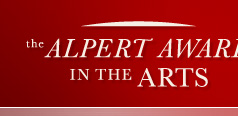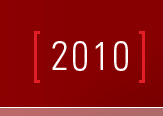astonishment
Hunch. Probe. Investigate. Focus. Dissatisfaction with the already known. Desire. In short: Curiosity, the core of creativity and the heart of the Alpert Award.
When the program began in 1994, we sought to identify artists who exhibited a capacity to wrestle with the given, to go further, and, in the process, to make something that matters.
Some time ago, I came across a talk writer and critic John Berger gave which perfectly described the ethos of the Alpert Award. He wrote, "...the basic cultural value of a prize depends upon what it is a stimulus to...If it stimulates imaginative independence, it encourages the will to seek alternatives. Or, to put it very simply, it encourages people to question."*
Across the five disciplines, and over the sixteen years, Alpert recipients embody these qualities. Here is how some of the artists have put it:
Musician Vijay Iyer said, "I took it as an urgent, timely directive to push myself further."
Filmmaker Peggy Ahwesh saw the prize as an "opportunity to shake myself up."
"The Alpert allowed me to not have to know where I was going, to stumble blindly until I found my way," choreographer Victoria Marks wrote.
"I want to make work that makes people brave." Lisa D'Amour, collaborative theatre artist
"I am interested in making abstraction and abstract painting relevant today, and doing so in a way that might subvert our usual ways of perceiving, that will open us up..." Byron Kim, artist
"I'm led to be an agent of transformation. I intend to keep questions spinning at this time when the answers are dropping to the ground in pools of wax and feathers. Look for me in the spaces between..." Daniel Alexander Jones, interdisciplinary theatre artist
"I make work that works to remake me." Paul Chan, artist
"I need to feel I'm learning with each new project, and that each work is a piece of a much larger puzzle." Rinde Eckert, interdisciplinary artist
"The greatest danger is believing that there is a right way to make a film." Ellen Bruno, filmmaker
Alpert panelists also manifest adventurousness, openness and the ability to ask, "what do we have here? What if?" Imagine the spirited conversations launched by people we've worked with, who include Tony Kushner, Trisha Brown, Don Byron, Yvonne Rainer, Julie Taymor, Maria Irene Fornes, Ann Hamilton, Garth Fagan, David Levi Strauss, Deborah Hay, Guillermo Gomez-Peña, and Anthony Davis
What goes on in the panel meetings? One full day of looking and listening to submitted work samples, reading musical scores, and re-reading applications, followed by a second day of talking and looking further. Every panel is different, yet certain patterns emerge. Listen to a few things panelists have said:
"I wanted to be taken off my guard," one panelist said. "I wanted to watch work that stepped off the edge into a new world." "And I," said another, "want a new vocabulary added to our language." Someone else described her bottom line: "This isn't a prize for someone who is doing a good job and coasting in a groove. I'm looking for something risky, some movement. As an artist you try and fight that groove." And: "We're looking for artists whose work is not 'finished.'" "...some kind of courage, some kind of boldness of the psyche." "Does one want transcendence, or something more complicated, which means that no one gets off the hook?" "How will the work of the artist we choose shape the field and influence the next generation and the discourse?" "Do we see the work as having the potential for impact outside of the art world?"
From the beginning, the prize was viewed as a way to encourage artists to take risks and, in the spirit of the prize, we continue to question what this means: How do you spot or measure this capacity? Besides, does risk even have an aesthetic anymore?
In the spirit of "not knowing" which work - and artist - will move forward, it's the very particular artists in concert with the guidelines, which inspire and generate the lively and very particular conversations. Still there are three questions (very much in keeping with the title of the book of interviews we published, The Force of Curiosity), which I inevitably ask as they move toward a decision: Surely subjective, they exhibit essentially the same issue: On the basis of the submissions, which work do you want to get to know further? Which work makes you curious? And, emerging from one wag of a panelist: Whose work would you go across town to see?
–Irene Borger
* John Berger, Selected Essays, Pantheon, c 2001, p. 253-255



